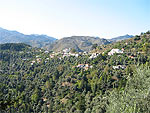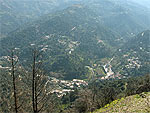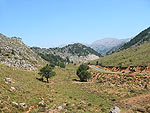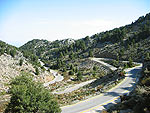| If you want to get away from hot and crowded Chania, the Omalos mountain plain is a good place to go. Furthermore the route offers many varied and fascinating sights. | ||||
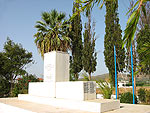
|
After the industrial area of Vamvakopoulo you can visit a monument to Cretans executed during the Second World War beside the road leading up to Galatas. | |||
| Next
to the monument is the prison with its beautiful rose garden, which the inmates
themselves take care of.
|
||||
|
After a little while a road leads to the Agia lake - a artificial fresh water lake, which all year round has an exciting bird life.
|
||||
| Before Fournes you pass the huge orange orchards which during winter most of all look like harmonious Christmas decorations with the many oranges embellishing the fresh, dark green leaves of the trees. | ||||
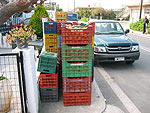
|
In wintertime there is quite a lot of traffic. The fruit pickers place the crates of oranges along-side the road, where they are collected by big trucks which drive them to agencies that export them, or to factories such as the Viochim in Chania, which produce big amounts of orange juice. | |||
|
From Fournes the road begins to ascend to Lakki, and after several hairpin bends you certainly feel that you are going up into the mountains. |
||||
|
From Lakki there is a great view over the valley, where among other things you can make out the villages of Meskla and Zourva. |
||||
|
|
||||
|
A few kilometres after Lakki you can make a little detour to the village of Karanou, where they have a cherry festival every summer. On the outskirts of the village tracks have been found from the ancient road to Omalos, the famous Road of Mousouros, known from the song 'Pote tha kani xasteria': |
||||
|
|
||||
| Πότες θα κάμει ξαστεριά, πότες θα φλεβαρίσει, | When will it be starry, when will it be February | |||
| να πάρω το τουφέκι μου, την έμορφη πατρώνα, | So I can grab my gun, my beautiful cartridge belt | |||
| να κατεβώ στον Ομαλό, στη στράτα τω Μουσούρω, | And walk down to Omalos on the Mousouros road, | |||
| να κάμω μάνες δίχως γιούς, γυναίκες δίχως άντρες, | I' ll deprive mothers of their sons and wives of their husbands, | |||
| να κάμω και μωρά παιδιά να 'ναι δίχως μανάδες, | I' ll deprive newborn babies of their mothers, | |||
| να κλαιν τη νύχτα για βυζί και την αυγή για γάλα | so they will cry for her breast in the night and in the early morning for milk, | |||
| και τ' αποδιαφωτίσματα για την καημένη μάνα. | and when the sun rises they shall cry for their poor mother. | |||
|
|
||||
|
After Lakki the road is narrow, and the asphalt needs a little maintance, but soon the road widens so much that coaches and other large vehicles can easily manage the bends without any problems.
|
||||
|
But soon after the road narrows again, simply because the terrain does not allow any widening of the road. After some hairpin bends you arrive at a small oblong plain called Fokies. |
||||

|
Here the Greek partisans killed a platoon of German soldiers in August 1944, while they were carrying supplies to their post on the Omalos plateau - as mentioned on the memorial tablet. | |||
|
|
||||
|
On the other side of the
road a church to the prophet Zacharias has been built in recent times.
|
||||
| After this the landscape changes, and the road continues along steep hillsides, where coniferous trees replace the hardwood trees. Shortly afterwards a steep hillside with some impressive hairpin bends awaits. | ||||
|
|
||||

|
On the top of the hill is a monument telling about one of the martial episodes during the Turkish period. On the stone is written: | |||
|
Αν θέλετε να μάθετε |
If you want to know | |||
|
και ποια 'ναι η γι αιτία |
what the reason was | |||
|
που σκότωσε το Βέργερη, |
for killing Vergeris, | |||
|
τ' αμμάθια τση Τουρκιάς |
this brave man amongst Turks | |||
|
Ο Γεωργιακάς τον σκότωσε |
Georgiakas killed him, | |||
|
γιατί κακά ελάλιε |
because he talked badly, | |||
|
τση χριστιαναίς ατίμαζε |
brought dishonour on Christian women | |||
|
και τσ' άντρες των κατάλυε. |
and did harm to their men. | |||
|
|
||||
|
On the smaller stone you get a more detailed explanation:
|
||||
| Στον τόπο αυτό το 1818 | Here at this spot in 1818 | |||
| ο Αντώνης Γεωργιακάς | Antonis Georgiakas | |||
| από την Αγ. Ειρήνη Σελίνου | from Agia Irini in the Selino district | |||
| εσκότωσε τον αιμοσταγή | killed the bloodthirsty | |||
| γεννίτσαρο Μεχμέτ Βέργερη | janizary Mehmed Vergeris | |||
|
|
||||
| From here there are only a few kilometres to Nerantzoporta, where the way down to the Omalos plain and the village of the same name begins. | ||||
| Read about the Omalos plain | ||||


